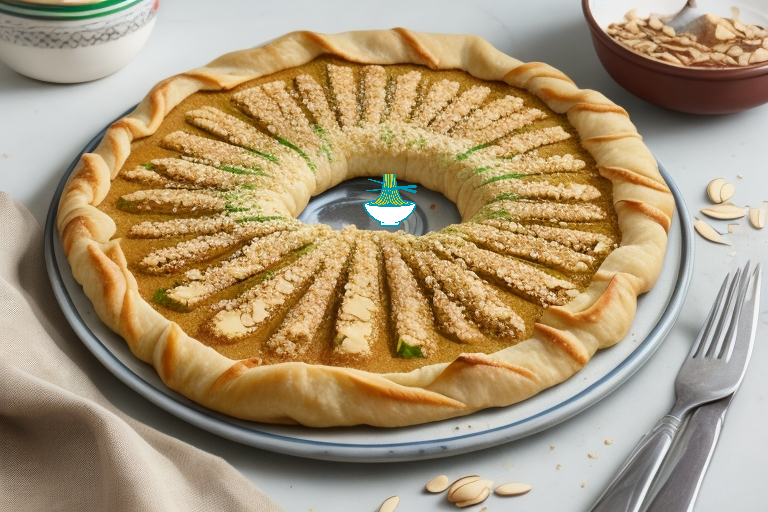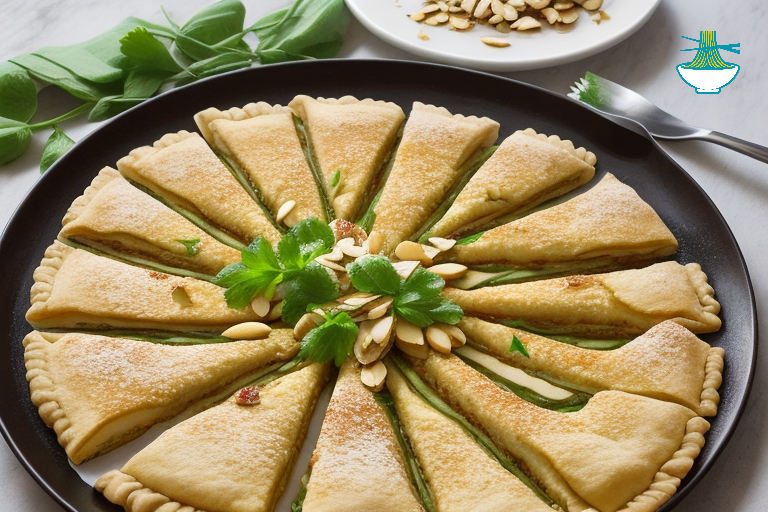Mhancha, meaning 'snake' in Arabic, is a traditional Algerian pastry celebrated for its unique coiled shape. Filled with a sweet almond mixture and delicately flavored with orange blossom water and spices, Mhancha offers a rich and flavorful experience. This delightful dessert is often prepared for special occasions like weddings and Eid, reflecting Algeria's rich culinary heritage. The combination of the crispy outer layer and the smooth almond filling creates a perfect balance of textures and flavors. Mhancha also carries cultural significance, as its snake-like shape symbolizes good fortune in many cultures. It is deeply rooted in the traditions of North African cuisine, blending the region’s love for intricate pastries with Moorish influences, such as the use of almonds and aromatic water. Enjoying Mhancha not only introduces you to Algerian flavors but also connects you with centuries of culinary tradition.

Ingredients:
For the Pastry:
- 300g (10.5 oz) fine semolina
- 200g (7 oz) all-purpose flour
- 1/2 teaspoon salt
- 1/2 teaspoon baking powder
- 120ml (1/2 cup) vegetable oil
- 120ml (1/2 cup) water
- 1 tablespoon orange blossom water (optional)
- Additional oil for brushing pastry layers
For the Filling:
- 200g (7 oz) blanched almonds, finely ground
- 100g (3.5 oz) granulated sugar
- 1 teaspoon ground cinnamon
- 1/2 teaspoon ground cloves
- Zest of one lemon
- 1-2 tablespoons orange blossom water
- 2-3 tablespoons water (as needed)
Instructions:
1. Prepare the dough: In a bowl, combine semolina, flour, salt, and baking powder.
2. Mix wet ingredients: In a separate bowl, mix vegetable oil, water, and optional orange blossom water.
3. Combine dry and wet ingredients: Gradually add the wet mixture to the dry ingredients, stirring with a fork. Knead until a smooth dough forms. Add more water if necessary.
4. Rest the dough: Divide the dough into small balls, cover with a damp cloth, and let rest for 30 minutes.
5. Prepare the filling: Mix the ground almonds, sugar, cinnamon, cloves, lemon zest, and orange blossom water. Add water until the mixture forms a paste-like consistency.
6. Preheat oven: Set the oven to 180°C (350°F).
7. Roll the dough: Roll each dough ball into a thin circular sheet. Brush with vegetable oil.
8. Assemble the Mhancha: Place almond filling along the edge of the dough, then roll into a long cylinder. Shape the cylinder into a coil.
9. Bake: Place the coiled pastries on a baking sheet, brush with oil, and bake for 20-25 minutes until golden brown.
10. Serve: Let cool before slicing. Serve with powdered sugar and mint tea.
Tips for Preparing Mhancha:
- Achieving the Perfect Texture: The key to a great Mhancha is ensuring the dough is smooth and pliable. Be careful not to overwork the dough, as this can lead to a tough pastry. If the dough is too dry, add a little water to achieve the right consistency.
- Preventing Burning During Baking: To prevent the Mhancha from burning, ensure that the oven is preheated to the correct temperature and monitor the baking time. If the pastry starts to brown too quickly, lower the oven temperature slightly. Brushing the pastries with oil can also help prevent them from drying out.
Note:
How to Modify the Recipe for Different Diets:
- For Low-Carb or Keto Diets: Replace the semolina and all-purpose flour with almond flour or coconut flour. These flours are lower in carbohydrates and suitable for people following low-carb or ketogenic diets.
- For Gluten-Free Diets: Almond flour or gluten-free all-purpose flour can replace the wheat flour. This will make the pastry suitable for individuals with gluten sensitivities or celiac disease.
- For Reduced Sugar Intake: To lower the sugar content, substitute granulated sugar with a sugar substitute like monk fruit sweetener or stevia. You can also experiment with reducing the sugar amount in the filling, especially if you prefer a less sweet treat.
- For Calorie Reduction: Use less oil in the pastry layers or substitute vegetable oil with a healthier fat option like olive oil. Additionally, using fewer almonds or reducing the amount of sugar can help lower the calorie count.
Frequently Asked Questions (FAQs):
Can Mhancha Be Stored?
- Yes, Mhancha can be stored for a few days at room temperature. To keep it fresh, store it in an airtight container. If you want to store it for longer periods, refrigeration is recommended. Simply reheat in the oven for a few minutes to regain its crispness.
Can I Use Alternative Ingredients?
Absolutely! Mhancha can be customized to fit different dietary needs:
- Gluten-Free: Use gluten-free flour alternatives such as almond flour or rice flour.
- Low-Sugar: Replace granulated sugar with natural alternatives like stevia, monk fruit sweetener, or agave syrup.
- Vegan: The recipe can be made vegan by using plant-based oils and ensuring the almond filling does not contain any animal-based products.
What Are the Best Beverages to Pair with Mhancha?
- Mhancha pairs beautifully with a variety of beverages. For a traditional touch, enjoy it with a cup of mint tea or Moroccan tea. If you prefer something cold, a refreshing glass of fruit juice or a creamy milkshake would complement the pastry's richness.

Health Benefits of Mhancha:
- Digestive Health: The semolina used in Mhancha is a good source of dietary fiber, which promotes healthy digestion and regular bowel movements. However, it is important to note that Mhancha contains high amounts of sugar, which can affect digestion, especially for individuals with insulin sensitivity or those managing blood sugar levels.
- Blood Sugar Levels: The recipe contains granulated sugar, which can quickly elevate blood sugar levels. While sugar provides quick energy, it's not ideal for people with diabetes or those trying to regulate their blood sugar. Replacing granulated sugar with natural sweeteners such as stevia or honey can offer a healthier alternative.
- Vitamins and Minerals: The almonds used in Mhancha provide healthy fats, protein, and minerals like magnesium and calcium, which are essential for bone health and muscle function. Additionally, cinnamon contains antioxidants that help reduce inflammation and regulate blood sugar, contributing to the health benefits of Mhancha.
Nutrition Value:
1. Fine semolina (300g/10.5 oz)
- Calories: 1,074
- Carbohydrates: 215g
- Protein: 30g
- Fat: 2g
- Sodium: 3mg
- Cholesterol: 0mg
- Vitamins: B-complex (especially B1, B3, and B9)
- Minerals: Iron, magnesium, phosphorus
- Nutritional Benefit: Semolina provides slow-digesting carbohydrates, which offer sustained energy. It also contains fiber and is rich in iron, essential for red blood cell production.
2. All-purpose flour (200g/7 oz)
- Calories: 728
- Carbohydrates: 152g
- Protein: 21g
- Fat: 2g
- Sodium: 2mg
- Cholesterol: 0mg
- Vitamins: B-complex (especially B1, B2, and B3)
- Minerals: Iron, manganese
- Nutritional Benefit: Flour adds structure and texture to the pastry. It also provides essential nutrients like B vitamins and iron, which are important for energy metabolism and oxygen transport.
3. Salt (1/2 teaspoon)
- Calories: 0
- Carbohydrates: 0g
- Protein: 0g
- Fat: 0g
- Sodium: 1,150mg
- Cholesterol: 0mg
- Vitamins: None
- Minerals: Sodium
- Nutritional Benefit: Salt enhances the flavor of the pastry and helps balance the sweetness of the filling. It is also an essential electrolyte for maintaining fluid balance and nerve function.
4. Baking powder (1/2 teaspoon)
- Calories: 1
- Carbohydrates: 0g
- Protein: 0g
- Fat: 0g
- Sodium: 240mg
- Cholesterol: 0mg
- Vitamins: None
- Minerals: Sodium, calcium
- Nutritional Benefit: Baking powder helps the pastry rise slightly, creating a lighter texture. It contains sodium and calcium, which contribute to electrolyte balance and bone health.
5. Vegetable oil (120ml/1/2 cup)
- Calories: 960
- Carbohydrates: 0g
- Protein: 0g
- Fat: 108g
- Sodium: 0mg
- Cholesterol: 0mg
- Vitamins: Vitamin E
- Minerals: None
- Nutritional Benefit: Vegetable oil provides healthy fats that help moisten the pastry and add flakiness. It is also a good source of vitamin E, which acts as an antioxidant and supports skin health.
6. Water (120ml/1/2 cup)
- Calories: 0
- Carbohydrates: 0g
- Protein: 0g
- Fat: 0g
- Sodium: 0mg
- Cholesterol: 0mg
- Vitamins: None
- Minerals: None
- Nutritional Benefit: Water is essential for binding the ingredients together and helps form a smooth dough. It plays a critical role in hydration and cellular function.
7. Orange blossom water (1 tablespoon, optional)
- Calories: 0
- Carbohydrates: 0g
- Protein: 0g
- Fat: 0g
- Sodium: 0mg
- Cholesterol: 0mg
- Vitamins: None
- Minerals: None
- Nutritional Benefit: Orange blossom water adds a subtle floral aroma and flavor to the pastry, enhancing its sensory appeal. It is used sparingly and does not contribute significant nutritional value.
8. Additional oil for brushing pastry layers
- Nutritional content depends on the amount used, but it generally adds extra fat and calories while contributing to the crisp texture of the pastry.
9. Blanched almonds, finely ground (200g/7 oz)
- Calories: 1,160
- Carbohydrates: 40g
- Protein: 40g
- Fat: 100g
- Sodium: 1mg
- Cholesterol: 0mg
- Vitamins : Vitamin E, B2 (riboflavin)
- Minerals: Magnesium, calcium, iron, potassium
- Nutritional Benefit: Almonds are rich in healthy monounsaturated fats, which support heart health. They also provide protein, fiber, and important minerals like magnesium and calcium, promoting bone strength and overall health.
10. Granulated sugar (100g/3.5 oz)
- Calories: 387
- Carbohydrates: 100g
- Protein: 0g
- Fat: 0g
- Sodium: 0mg
- Cholesterol: 0mg
- Vitamins: None
- Minerals: None
- Nutritional Benefit: Sugar adds sweetness to the filling. It provides quick energy but should be consumed in moderation due to its impact on blood sugar levels.
11. Ground cinnamon (1 teaspoon)
- Calories: 6
- Carbohydrates: 2g
- Protein: 0g
- Fat: 0.1g
- Sodium: 0mg
- Cholesterol: 0mg
- Vitamins: Vitamin K
- Minerals: Calcium, manganese
- Nutritional Benefit: Cinnamon has antioxidant and anti-inflammatory properties. It also helps regulate blood sugar levels and adds a warm, spicy flavor to the filling.
12. Ground cloves (1/2 teaspoon)
- Calories: 3
- Carbohydrates: 1g
- Protein: 0.1g
- Fat: 0.1g
- Sodium: 1mg
- Cholesterol: 0mg
- Vitamins: Vitamin K
- Minerals: Manganese, calcium, magnesium
- Nutritional Benefit: Cloves are packed with antioxidants and offer anti-inflammatory benefits. They provide a robust flavor and enhance the overall taste of the filling.
13. Zest of one lemon
- Calories: 5
- Carbohydrates: 1.6g
- Protein: 0.1g
- Fat: 0g
- Sodium: 0mg
- Cholesterol: 0mg
- Vitamins: Vitamin C
- Minerals: Potassium
- Nutritional Benefit: Lemon zest adds a refreshing citrus flavor to the filling. It also provides a small amount of vitamin C, which supports the immune system.
14. Orange blossom water (1-2 tablespoons)
- Calories: 0
- Carbohydrates: 0g
- Protein: 0g
- Fat: 0g
- Sodium: 0mg
- Cholesterol: 0mg
- Vitamins: None
- Minerals: None
- Nutritional Benefit: Orange blossom water enhances the flavor of the almond filling with a floral note. It does not contribute significant nutritional value but boosts the dish’s aroma and sensory appeal.
15. Water (2-3 tablespoons, as needed)
- Calories: 0
- Carbohydrates: 0g
- Protein: 0g
- Fat: 0g
- Sodium: 0mg
- Cholesterol: 0mg
- Vitamins: None
- Minerals: None
- Nutritional Benefit: Water helps bind the ingredients in the filling to achieve the right consistency for shaping and rolling. It does not add any caloric or nutritional value.
In summary, this recipe combines nutrient-rich almonds, flavorful spices, and citrus zest with traditional pastry ingredients like semolina and flour. Together, they provide a balance of healthy fats, proteins, and essential vitamins, while the spices contribute antioxidants and anti-inflammatory benefits.


Comments